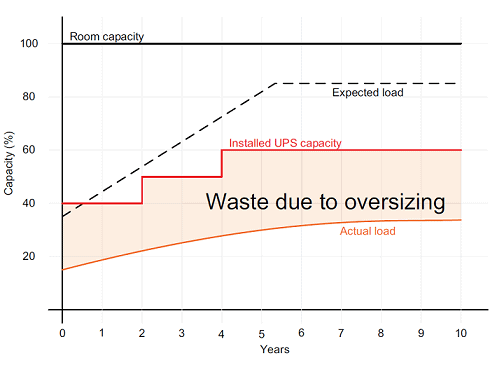Data centre operators must continuously seek to improve the electrical efficiency of UPS systems to counteract rising energy costs and to provide a green environment, which complies with relevant legislation. Reviewing a facility’s UPS system often suggests valuable contributions to this drive.
In this article, Alan Luscombe, director at KOHLER Uninterruptible Power Ltd., a KOHLER company, explains the opportunities for energy savings that can exist within a UPS installation.
Data centre operators are under steady pressure to run a facility with visibly green attributes. Not only does this become increasingly important as electricity prices inexorably rise, but it also improves a data centre’s carbon footprint, in line with corporate responsibility endeavours. This contributes to an amenable working environment and enhanced relationships with local communities, whilst meeting legislative pressures and incentives to create and maintain ecologically responsible businesses.
Many large undertakings, for example, qualify for participation in the Energy Savings Opportunities Scheme (ESOS), an energy assessment and saving scheme run by the Environment Agency. Organisations that meet these definitions[1] must carry out an ESOS assessment covering all their energy use, unless they have an up to date, comprehensive ISO 50001 energy management system that’s certified by an accredited certification body.
ESOS compliant energy audits must identify energy-saving opportunities, although these should be reasonably practical and cost-effective to implement. Participants will probably wish to implement any such opportunities, provided the money saved by reduced energy use exceeds the cost of implementation. However, there is no regulatory requirement to do so.
Any participant comprising or including data centre operations will almost inevitably contain a power protection system complete with an uninterruptible power supply (UPS). This can offer opportunities for energy savings depending on the type of UPS power supply installed, and how it is being used. Ideally the onsite UPS installation comprises a modern modular UPS system which can deliver great UPS efficiency, as well as other benefits, including high availability and scalability. However, in reality many sites have older legacy UPS systems – and these are where the energy reduction opportunities can mainly be found.
Transformerless UPS systems technology vs legacy UPS installations
Energy savings arise firstly from a move to modern, transformerless UPS technology made possible by advances in power semiconductor technology and the advent of Insulated Gate Bipolar Transistor (IGBT) devices. The technology is more efficient than the earlier, transformer-based UPS system designs, with an overall improvement in UPS efficiency across the load spectrum of around 5%. This yields substantial reductions in heat losses and energy running costs.
Transformerless UPS systems also bring the input power factor closer to unity, with less load dependence. Input current magnitude is decreased, with associated reductions in switchgear and cable sizing. In some cases, electricity running costs are also reduced.
Legacy UPS systems are often operated below their optimum efficiency, because they are not easily scalable. This lack of scalability means that until recently many uninterruptible power supplies were significantly oversized, to allow for the prevailing load and any expected future growth. The graph in Fig. 1 demonstrates this by showing an expected load profile that starts at 35% of the data centre capacity, with a projected growth to 90% of UPS capacity over 10 years.
The same graph also reveals that an uninterruptible power supply sized for 100% data centre capacity was installed, yet in reality the load only ever reached 35%; accordingly, the UPS remained significantly underloaded, seriously impacting its efficiency over its lifespan. A legacy uninterruptible power supply has a maximum efficiency of about 93% when fully-loaded, dropping to about 90% at 50% loading, and even less at the levels shown in the graph.
Fig.1: UPS capacity waste due to oversizing in a legacy uninterruptible power supply
By contrast, the graph in Fig. 2 shows how a modern, modular transformerless UPS system can be applied to the same load and expected growth rate. The UPS capacity originally provided needs only to exceed the actual load slightly, because it can be increased so easily, and incrementally, as and when the load grows.
KUP’s KOHLER PW 9500DPA, for example, can start as a single cabinet with one 100 kW UPS module, often with one more for UPS redundancy. As the load grows, the uninterruptible power supply can be vertically scaled in 100 kW increments by populating the cabinet up to its full 500 kW UPS capacity. Horizontal scaling is also possible, by paralleling up to six frames for a total 3 MW capacity. The ability to continuously ‘right-size’ the UPS capacity to the load allows users to minimise their power and cooling requirements, reducing power usage over the life of the UPS power supply.
Fig.2: UPS capacity waste due to oversizing in a modern modular UPS system
The modular topology benefits from the improved UPS efficiency of transformerless technology compared with legacy transformer-based UPS systems. Modular UPS systems like the KOHLER PW 9500DPA, and as shown in Figure 2’s example, have a high, flat efficiency/load curve, reaching 96.1% maximum at 50% load and dropping to 95.8% at 25% load.
The overall energy savings, over several years, from migrating to a modular UPS system from a poorly-utilised legacy UPS installation can be quite considerable, as Table 1 shows.
Table 1: Comparative legacy vs modular running costs for a parallel redundant UPS system supporting a 120kVA load
Note also that the load/efficiency curves for modern, modular UPS systems are designed to accommodate redundant configurations. These curves are not entirely flat, but instead produce slightly higher UPS efficiency at partial loads. This is because uninterruptible power supply manufacturers recognise that modular UPS systems are typically operated in redundant mode, so no single module will be fully loaded. For example, in an N+1 UPS system comprising two modules in parallel and sharing the load equally, neither will ever have more than 50% loading. Accordingly, the uninterruptible power supply manufacturers have shifted the maximum UPS efficiency performance to the actual point of use. This is reflected in the curve for the 9500-DPA UPS power supply, which, as in the example above, peaks at 96.1% efficiency at 50% load.
Eco-mode
Boosting UPS efficiency to 99% by operating it in eco-mode is also possible. However, this mode carries risk as well as improved efficiency, so it should only be used after careful consideration of the critical load and site conditions. In eco-mode, power flows directly from the raw mains to the load, bypassing the power protection and filtering provided by the UPS rectifier and inverter components. Additionally, the UPS systems must recognise any mains power problems or failures, and switch the load to inverter to assure ongoing, clean power from the UPS battery.
Therefore, eco-mode is a viable option only if two conditions are met:
- The load is resilient to any disturbance that could reasonably be expected from the incoming mains
- The load can ride through the time taken for the uninterruptible power supply to detect power problems and transfer to inverter accordingly.
Ultimately, the question is about whether the 2 or 3% improvement in UPS efficiency is worth the increased risk to the critical load.
Conclusion
Data centre operations are under pressure to improve energy efficiency, may benefit from reviewing their UPS installations. It could offer opportunities for energy saving, especially if UPS systems are based on older technologies.
Additionally, the flat efficiency/load curves offered by modern UPS systems mean that they can be deployed in redundancy mode for greater resilience, while possibly improving rather than sacrificing UPS efficiency.
UPS systems can be run in eco-mode to further improve efficiency, but the decision to use this option depends very much on the nature of the load supported by the uninterruptible power supply.
If you have any questions about our uninterruptible power supplies or UPS services please get in touch with KOHLER Uninterruptible Power via our contact page or call us on 0800 731 3269.
As provided within the Environment Agency’s document ‘Complying with the Energy Savings Opportunities Scheme’.
Article published in Electrical Review March 2017 and Networks Europe July/August 2017








